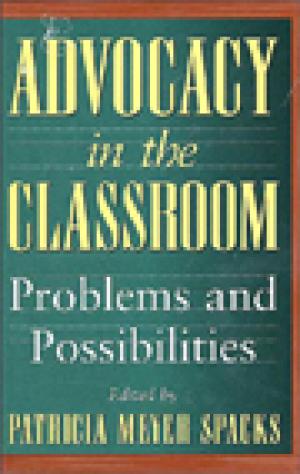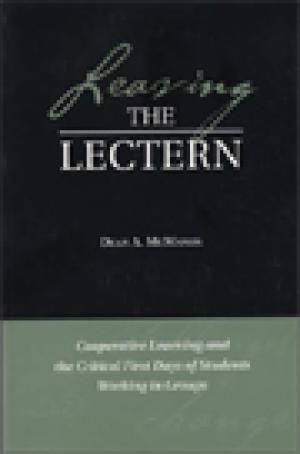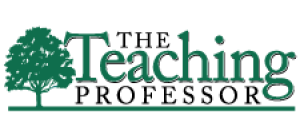Resources

Noted literary critic Patricia Meyer Spacks has gathered together a group of both liberal and conservative professors to answer the question of whether or not a teacher can still bring passionate commitment to an idea into the classroom as a way of engaging students in a meaningful way. (From the Publisher)

This book presents a national award-winning approach to encouraging dialogue among interdisciplinary faculty about ways to reflect on and broaden their repertoire of teaching skills. Based on the "Dear Abby" advice column format, the process was developed to initiate a dialogue on best practices, successes, and ways to address frustrations in teaching. Faculty from four different disciplines (math, chemistry, physics and engineering) began asking questions about their instructional practices and thinking about teaching in a more scholarly way. A team of outstanding teachers from across Northeastern University and the staff of the Center for Effective University Teaching formed a community of practitioners to construct responses to common teaching challenges, drawing upon the literature on effective teaching as well as their own personal experience. The resulting "columns" were sent to faculty via mass e-mail in the form of suggestions from "Jonas Chalk," an experienced teacher/advisor colleague. Topics were archived and posted on a website. Each quarter, one column was included for publication in the teaching center's newsletter. Topics Jonas tackled included testing approaches, effective uses of office hours, the ways and hows of asking questions in class, dealing with disruptive classroom behavior and much more. The mechanism garnered enthusiastic responses across disciplines; faculty were eager to share their concerns as well as techniques they had developed. Significant numbers of the faculty put the columns' ideas to work in their classrooms. Faculty interested in practicing the scholarship of teaching, while dealing with common classroom concerns, will be able to increase their understanding of classroom dynamics and their repertoire of teaching skills through the concepts and resources described in this book. Written in entertaining, enjoyable and readable prose, Chalk Talk includes a history of the project's development, the actual columns grouped into chapters by topic, and responses from faculty about how the column helped them with their teaching. (From the Publisher)

This fine sourcebook provides college and university teachers, across the curriculum, with specific classroom-tested activities and assignments to stimulate and develop student critical thinking. The book consists of fifty modules, each containing: * A description of a critical thinking assignment, * An explanation of the assignment's purposes and benefits, * A discussion of ways to use or modify the assignment in the classroom, and * Suggested related activities, including relevant bibliographical sources. Most modules were developed by the author; in other cases, the author shaped, refined, and expanded on material that has been developed and used by colleagues. Some modules are discipline-specific, some are suitable for a number of disciplines; and many can easily be modified for use in a wide variety of fields. The assignments vary in scope, difficulty and complexity. Some are deigned for introductory freshman courses, while others have been used in graduate courses but could be adapted for lower level courses. Each module stands alone, but the modules are loosely grouped into five sections: (1) Problems and Puzzles (2) Analyses and Critiques (3) Opinions, Decisions, Values (4) Projects, Experiments, Adventures (5) Student as Teacher, Teacher as Student. The sourcebook also includes an introductory chapter on the nature and importance of critical thinking, a cross-referencing of all activities by discipline, and a wide-ranging bibliography. Cultivating Judgment has been extensively tested in college classrooms, then revised, expanded and significantly improved. The author has conducted extensive research on the teaching of thinking skills, and discovered that discovered that no existing source filled the need for a book that spells out and demonstrates how to teach critical thinking in virtually any discipline, from liberal arts to more specialized career programs. You will find Cultivating Judgment to be an engaging book, and one that combines intellectual rigor with a playful, creative spirit – and, one that can be used as a textbook in a general course on critical thinking, or as a resource for teachers across the curriculum! (From the Publisher)

Teaching Inclusively brings together a broad array of current "best practices" in the design, implementation, and assessment of multicultural change initiatives on college and university campuses. Readers will find that this volume advocates for more transparent connections between change initiatives at individual, departmental, and college-wide levels by highlighting the ways in which such practices and change goals can relate to and support each other, thus addressing a noticeable absence in the current available literature. The contributors to this volume present readers with a balance between theoretical models and demonstration projects that address change processes at three levels: individual courses, programs and departments, and across schools and institutions. In addition, there are descriptions of current, multi-year or multi-phase efforts at both departmental and organizational levels. Whenever possible, the contributors include their perspectives on important lessons learned from their efforts. Finally, we offer resource materials that promise concrete support for applications. Part I addresses models and perspectives that help to conceptualize, implement and assess diversity-related instructional and faculty development programs at the systemic level. Contributors offer models and descriptions of practices aimed at making transparent the values, beliefs, and goals that shape institutional and classroom climates. Note that in the context of this volume, "diversity" is deliberately defined broadly to encourage a more systemic approach to the analyses of and response to diversity-related issues. For many readers, this may offer new dimensions and greater texture to their current conceptualization of diversity. This section reflects the contributors’ interests in analytical tools and organizational frameworks useful in addressing individual, departmental, and institutional changes. Whenever appropriate, authors in this section identify a range of practical applications, such as course-based efforts in the major to courses that fulfill general education requirements. In Part II, contributors describe change initiatives that use departments (or programs) as the unit of analysis for diversity-related change efforts. In this section, readers will benefit from the descriptions and assessments of programs designed specifically to bring faculty and academic administrators together in cohorts to address diversity and teaching development goals within the disciplines in a sustained dialogue on diversity. Assessment of current efforts indicate that such initiatives illuminate the content, skills, and values necessary for sustained change and that such experiences can become important models for broader institutional change efforts. In Part III, the contributors discuss multicultural change efforts at the college or institutional level directed at creating and sustaining more inclusive teaching and learning communities. Additionally, contributors describe programs and practices useful in addressing diversity issues across the disciplines as well as within discipline-specific contexts. Particular emphasis is placed on understanding how can systematic multicultural organization change initiatives can support a departmental or campus-wide emphasis on teaching inclusively. These chapters offer rich descriptions of efforts at institutions learning how to address diversity-related initiatives in a sustainable, comprehensive manner. Such efforts can help others determine how best to assess their organization’s needs and strengths, and to determine what is needed in the larger environment to initiate and sustain successful pro-equity organizational change and innovations. Finally, Part IV pays particular attention to resources and program models particularly useful for faculty developers and centers. Contributors to this section provide a rich set of tools for self and course assessment, planning for new or revised programs, and suggesting well-proven strategies for approaches to diversity-related teaching development and organizational change initiatives. These include descriptions of specific, "hands on" consultation practices, workshop exercises, resource materials, and design elements (e.g., use of writing prompts) proven effective across the disciplines in engaging faculty in reflection, analysis, dialogue and innovation related to diversity-related teaching development goals. (From the Publisher)

The Way of the Teacher, written by educator J. M. Haile, is for the dissatisfied teacher: one who conscientiously performs the job but who feels that students are not benefiting as much as they should; one who wants to continue growing in the profession but who needs guidance and encouragement; one who aspires to master teaching and inspire students. Such teachers can be found at every institution of learning, in every discipline, and at every level of experience. The intent is to help teachers improve. But no quick fixes are offered here: this book is not about the mechanics of teaching or learning. Instead, in The Way of the Teacher Haile tries to illuminate certain issues that teachers should resolve in their own minds, if they are to master the profession. The most unusual feature of the presentation is its structure: rather than a formal academic monograph, the book is small, of few words, and to the point. The aim is not to convince, but to stimulate: the book is not a map, but a sign post. Nearly every page contains a highly charged phrase that challenges teachers to think more deeply about what they do; e. g., "Let's stop teaching the courses, and start teaching the students." The Way of the Teacher combines the author's years of experience in the classroom with recent advances in educational psychology and cognitive science. In the book, Haile deftly reaches across established disciplines to explore those difficulties that are common to most teaching and learning situations. The book reflects deep thinking about the plight of the student, who is often unsure of what learning really is, and the plight of the teacher, who is often unsure of what teaching really should be. (From the Publisher)

Lack of time may be the single most commonly experienced problem among American faculty. It is fair to say that the overwhelming majority of the roughly 400,000 full time faculty in American colleges and universities feel overloaded in their teaching lives; they perceive that they do not have time to do their basic faculty duties properly; and they believe that overload goes with the job. We complain yet we do not reflect on and evaluate our paradigms for how we use our time. Perhaps a pernicious norm has evolved: anyone not complaining about being overwhelmed is suspect. We act as if we have no choice. Einstein once remarked, "Insanity is doing the same thing over and over again and expecting different results." A Lakota Sioux saying puts the idea in concrete terms, "When your horse is dead, the proper strategy is to dismount." When it comes to avoiding overload, many of us sit on our dead horses kicking them in the sides over and over again, insanely, wondering why we don't get anywhere. However, we do have choices about how we use our time. Einstein suggested a way to discover our choices when he further observed, "Problems cannot be solved at the same level of awareness that created them." Essentially, that is the objective of this book: to elevate our awareness of how we use our time and how we might improve that use of time. We need to shift our perspective on using time from subject (a perspective from which we act naively) to object (a perspective on which we act intentionally). The tool that we will use to stimulate this shift in awareness comes from a vintage analysis of systems theory and research and focuses on managing the boundaries of our teaching selves better. In Making Time, Making Change, author Douglas Reimondo Robertson leads you on the road to a more rewarding, and less harried, teaching life! (From the Publisher)

“Academic leaders may be the least studied and most misunderstood management position in the world,” authors Gmelch and Miskin state. Although chairs come to the position for varied reasons, few come with any specific leadership training. Once in the position, they are critiqued, judged, and evaluated by both their faculty and administrators—groups which frequently have conflicting criteria. Based upon their extensive study of the demands on and needs of chairs, the authors have distilled their findings into a practical and highly accessible volume to guide chairs in their growth. Despite the varied paths to the position, the authors state that all chairs find themselves in an environment distinct from their former faculty situation. One of the most dramatic changes is that chairs need the ability to switch from one task or situation to another very quickly and must develop a facility for refocusing. As chairs, individuals assume four basic roles: faculty developer, manager, leader, and scholar. Because of these roles and the need to quickly refocus, Gmelch and Miskin advocate becoming a swivel chair. They state: “To balance their roles, chairs must learn to swivel without appearing dizzy, schizophrenic, or ‘two-faced.’” (From the Publisher)

This book records the story of how one professor at a research university used a form of active learning to change the way he taught— from traditional lecture and examinations to cooperative learning and student projects. Drawn from teaching notes, conversations with students, student evaluations, and annual reports, readers will learn the kinds of risks, assumptions, and decisions they will face as they change their teaching to emphasize student learning, particularly during the critical first days of change. Engagingly written, Leaving the Lectern offers an honest and insightful look at the challenges and rewards of achieving change in the classroom. This book: * Motivates faculty and graduate students to visualize what changing their teaching to enhance student learning will be like by illustrating through narration how a professor much like them made the change * Provides reflective questions at the end of each chapter to help readers use the information in the chapter * Enhances the readers' preparation for the change by citing references to pedagogical precepts, strategies, and tools * Summarizes the seven themes found in the book to help bring about the change (From the Publisher)

Journal Issue.

This book emerges from the Carnegie Foundation for the Advancement of Teachings study of the most pressing concerns involved in preparation of clergy across all faiths and denominations. Working with accrediting bodies and professional associations as well as the educational institutions themselves, the findings reported in this book can be used to improve the quality of education for future ministers, priests and rabbis. (From the Publisher)